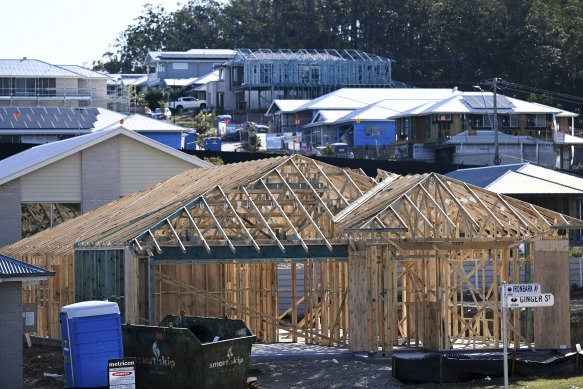This was published 6 months ago
Five options for slashing landlord concessions to help fix the housing crisis
By Rachel Clun
Slashing property investment tax concessions could help address the housing crisis and net the federal government up to $60 billion in additional tax revenue over the next decade, with key independent senators demanding it be on the table in the upcoming budget.
Separate research shows Australia’s housing crisis will continue for years as home construction fails to keep up with demand, and an unlikely coalition of property groups and social services organisations has united to urge the government to double the Housing Australia Future Fund to fix the housing shortage.

Australia’s housing crisis is likely to get worse before it gets better, a new report from Deloitte Access Economics has found.Credit: Dan Peled
Independent senators David Pocock and Jacqui Lambie said negative gearing and capital gains tax changes needed to be part of the mix if the federal government was serious about boosting housing supply and improving affordability.
“The housing crisis is so widespread and so severe we need governments pulling every available lever to increase housing supply and affordability,” Pocock said.
Following the federal government’s reversal on changes to stage 3 income tax cuts, Labor has been under sustained pressure to take on broader tax reforms.
But, as he has done several times before, Treasurer Jim Chalmers ruled out any changes to negative gearing when he was asked on Monday if it would be considered before the May 14 budget, saying simply: “No.”
The senators asked the independent Parliamentary Budget Office to look at five potential changes to negative gearing and capital gains tax concessions for investors.
Lambie said mum and dad investors and retirees who poured their money into the property market needed to be protected as part of the solution.
“Senator Pocock and I have done the work and I hope the treasurer and the prime minister will be brave and take this opportunity to consider these sensible reforms,” she said.
The most moderate option would grandfather the capital gains tax discount for existing property but not new builds and limit negative gearing to one investment, delivering an additional $15.6 billion in tax revenue over the next decade.
The option with the most significant changes would grandfather capital gains tax except for new builds and remove negative gearing altogether, providing nearly $60 billion in additional tax revenue to 2033-34.
The Parliamentary Budget Office said all the estimates were subject to uncertainties, particularly around residential property prices and behavioural responses to the changes in the market.
It said changes to negative gearing would lead to a “significant bring-forward” of property sales and purchases by investors, which would be immediately followed by a fall in demand for investor housing once the policy kicked in.
“Property prices would decline, while other asset prices, such as those of Australian shares, would increase,” the report said.
Separate research from Deloitte Access Economics noted Australia has not been building enough homes to keep pace with population growth for many years, and would continue to lag demand for years to come.
Deloitte Access Economics Partner and report lead author, Stephen Smith said the pandemic backlog meant the construction industry was struggling to start new builds.
“Correcting Australia’s housing disaster will take years and, unfortunately for many, will require higher house prices in the near term,” he said.
“In all likelihood, this is a problem that will get quite a lot worse before it gets better.”
The federal government has a range of schemes to help address the housing crisis, including its cornerstone $10 billion Housing Australia Future Fund, and public consultation has begun for its Help to Buy shared equity scheme.
Housing Minister Julie Collins said the scheme, in which the government will provide up to 40 per cent of the equity to help eligible homebuyers into the housing market, would be life-changing for many Australians.
“Our ambitious housing reform agenda is working across the board – more help for homebuyers, more help for renters and more help for Australians needing a safe place for the night,” she said.
But an alliance of organisations including ACOSS, Master Builders Australia, the Housing Industry Association, the Community Housing Industry Association and Homelessness Australia were pushing the federal government to do more, including doubling the Housing Australia Future Fund investment to $20 billion in the upcoming budget.
They said that increase, as well as ensuring state and territory governments are held to account for delivering on housing promises, would help the government meet its target of building 1.2 million homes by 2029.
Property Council Chief Executive Mike Zorbas said there was no time to lose.
“We are at a housing crossroads. The government should double down on its leadership position and help states and territories speed up planning and housing supply across the board,” he said.
Cut through the noise of federal politics with news, views and expert analysis. Subscribers can sign up to our weekly Inside Politics newsletter.